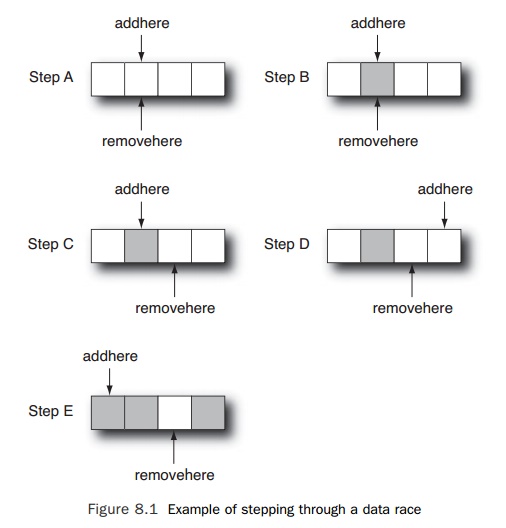Chapter: Multicore Application Programming For Windows, Linux, and Oracle Solaris : Hand-Coded Synchronization and Sharing
Modifying the Producer-Consumer Code to Use Atomics
Modifying
the Producer-Consumer Code to Use Atomics
Since adding an item into the circular list and removing an item from
the list look like single operations, it is tempting to imagine that they could
be implemented using atomic operations. We will explore this scenario using the
modified code shown in Listing 8.28. In this code, each producer thread waits
until the next entry in the buffer is free and then attempts to atomically add
an item into that buffer location. If successful, it incre-ments the pointer to
the next entry in the list. Similarly, all the consumer threads wait until an
item is placed into the list and then try to atomically remove the new item.
The thread that succeeds increments the pointer to the next entry in the list.
Listing 8.28 Using
Atomic Operations to Handle a Circular List
void addtobuffer( int value )
{
int success = 0;
while ( !success )
{
if ( buffer[ next(addhere) ] == 0 )
{
if ( CAS(
&buffer[ next(addhere) ], 0, value ) == 0 )
{
addhere = next(addhere);
success = 1;
}
}
}
}
int
removefrombuffer()
{
int value;
int success = 0; while ( !success )
{
if ( ( value = buffer[removehere] ) != 0 )
{
if ( CAS(
&buffer[removehere], value, 0 ) == value )
{
removehere = next(removehere); success = 1;
}
}
}
return value;
}
At first, it appears that this should work. Only
one thread at a time can successfully add or remove an element. Only that
thread will alter the pointer so that it points to the next entry.
However, this is not the case. It is critical to
realize that although instructions will execute in the expected order, the gaps
between the execution of adjacent instructions are random. A pair of
instructions could be executed on the same cycle or with a separa-tion of only
a few cycles. However, a thread may be context switched off the virtual CPU
between the two instructions, and this would cause a gap of thousands of cycles
to occur between the two operations.
Consider the situation shown in Figure 8.1 where
multiple producer and consumer threads exist. At step A, two producer threads
are attempting to add an item into the cir-cular buffer. They both reach the
CAS instruction at nearly the same time, but one of the threads gets context
switched off the CPU at that very moment. At step B, the other thread
successfully enters its value into the circular list and is just about to move
the addhere pointer
onto the next element when it too is context switched off the virtual CPU.
While the first thread is off-processor, one of the consumer threads
come along and removes the recently inserted element, as shown in step C. At
that point, the first thread

is switched back onto the CPU, and it sees that the slot it was planning
to use is now empty. It atomically inserts its item of data into the circular
buffer and then increments the pointer to the next place to insert an element.
This is rapidly followed by the second producer
thread being brought back onto a virtual CPU. It completes the operation it was
performing when it was context switched off the virtual CPU, and it too
increments the addhere pointer
to the next place to insert an element. This causes the addhere pointer to skip a location, but the removehere pointer, which indicates where to remove elements from, is now pointing
at the skipped location, as shown in step D. The skipped location is empty, so
the consumer threads are left waiting for an element to be inserted there. This
cannot happen until the producer threads have filled up the entire circular
buffer. However, before the producer threads can fill the entire buffer, they
hit a filled element in the buffer and cannot make progress until this element
has been removed, which will never happen because of the stalled consumer
threads.
Consequently, the application deadlocks with both the producer and
consumer threads unable to make forward progress.
Related Topics